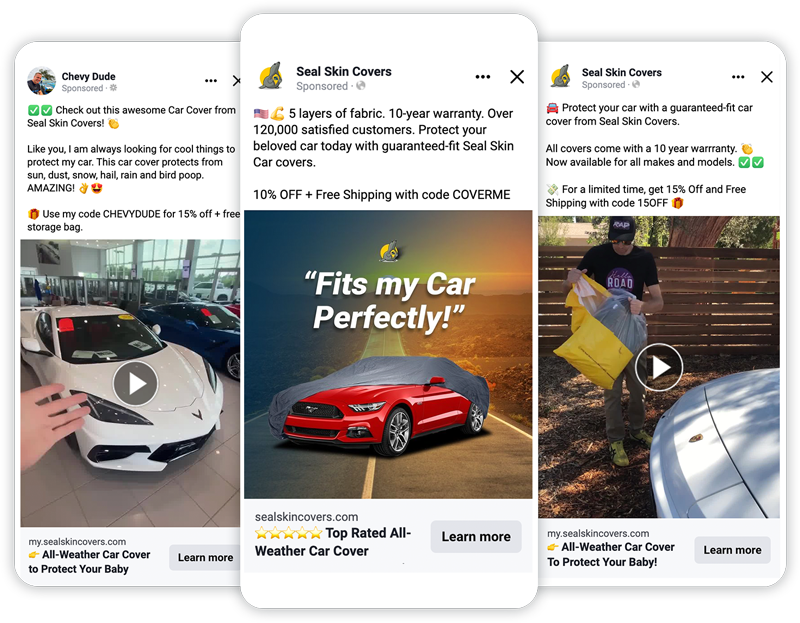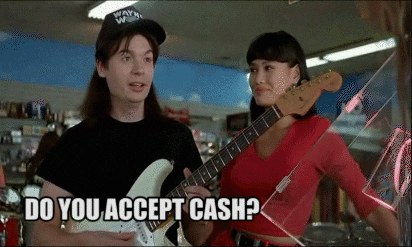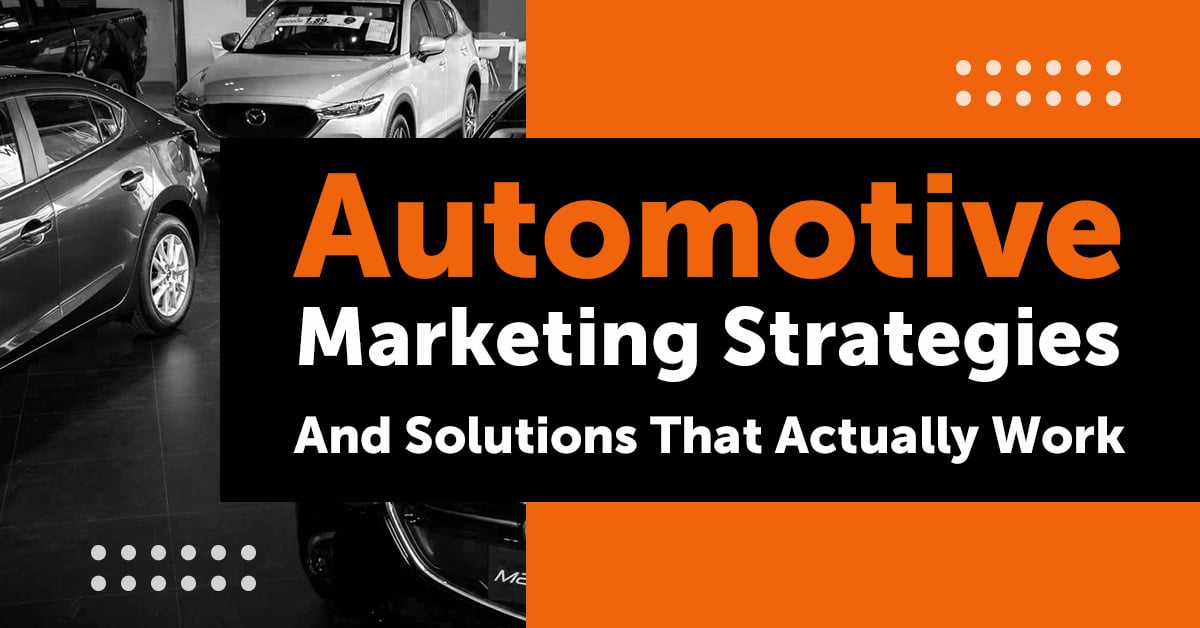For you, it’s simple. Automotive marketing strategies should work all the time, every time, without spinning your wheels or leaving customers exhausted by what’s seeping out of your tail-pipe.
And the truth is some auto marketing solutions stand out for their cost-effectiveness. Tried and true, these strategies help auto companies like yours reach new audiences, build loyalty, and drive revenues.
Automotive Marketing Strategies for SEO
#1. Plan to Get and Stay on Top
To modify a famous saying: If you fail to plan, you plan to waste a ton of money on SEO.
Getting to the top of searches is the goal. You’re invisible otherwise. The top 3 get over half the clicks, and page 2 gets less than 6%.
Knowing what automotive marketing solutions work and what’s not worth your time is important. And SEO works, but only when you apply an effective SEO strategy to earn prime search real estate.
To get started, research the things consumers are searching for that matter the most to your brand. What do you need to do to earn those top spots, and what resources will you need to accomplish it?
SEO isn’t quick, but it’s sustainable once you gain a foothold in these prime searches.
Remember: No auto marketing solutions will deliver results in perpetuity if you stop investing. SEO should be thought of as a long-term strategy that can cut costs over time and drastically increase your ROI.

#2. Practice Comprehensive SEO
SEO is more than targeting the right keywords. And it’s more than site speed and user-friendliness.
A half-optimized site is like an unoptimized website. (Head scratcher. We know.)
Getting to the top of search results requires a combination of 4 types of SEO. And if we’re brutally honest, many people think they’ve SEO’d their website by only doing 1 or 2 of these.
- Technical SEO — Ensuring your website and pages meet technical requirements to appear on search engine results pages. Without it, you’ll go nowhere fast, if at all. Speed, navigation, user experience, responsive images, and mobile-friendliness are super fundamental to SEO. Nothing else matters if you haven’t optimized these first.
- On-page SEO — Researching keywords and aligning content with search intent down to every detail. Automotive blogging, conversion rate optimization, structured data, metadata, URL structure, and internal linking strategies are critical to keeping people on the page and engaged to show Google your site is relevant to searchers.
- Off-page SEO — Networking off-site to build an online presence, drive quality traffic to your website, and increase your authority and relevance (social media, review sites, link building, citations, influencer marketing, etc.)
- Ongoing SEO — Staying current with algorithm updates, tracking the competitors, addressing tumbling rankings and algorithm updates quickly, and continually investing in helpful content to communicate authority, relevance, and currentness.
#3. Target the Right Keywords
Some people try to downplay keywords. As the story goes, they don’t matter because search engines use machine learning. Fancy!
Keywords are soooooo 2014.
Nope.

Keywords still represent what people are looking for in the search results. As an automotive business, you research keywords to understand how people find a site like yours and what they need to see to choose your site — and buy.
But even knowing this is not enough.
You can spin your wheels for months — or years — high-speed-chasing high-volume keywords if they don’t align well with what your company actually does.
In other words, you’ll attract the kind of traffic that’s only suitable for parts. To target the right keywords, you need to understand search intent.
#4. Discover Search Intent
When you perform a Google search, you have an idea of what you’re looking for. And when you see it, you’ll click it — you don’t browse like that person who spends an hour at the sale rack, then walks out of the store with nothing.
All searchers have the intent to click on something when they search. They will click the item that best aligns with it.
The more closely your website’s preview in the search results aligns with intent, the more likely they are to click.
You’ve got to get into their heads. Is this person looking for a guide, video, something updated this year, or a particular brand? You need to know to top this search.
You can use all kinds of advanced analytics to do this. And that will save you a lot of time. This is what your top competitor’s automotive marketing company probably does.
But one of the easiest ways to start understanding search intent is this.
- Choose a keyword phrase you’d like to target
- Search for it on Google
- Analyze each website on page one (or at least the top 3) and ask yourself: Why does Google think this is the most relevant search result for this query?
That’s search intent.
Best Content Marketing Strategies in the Automotive Industry
#1. Short-form Video
Short-form video continues to dominate video marketing. Like it or hate it, TikTok is popular for a reason. And it’s no secret Instagram, and YouTube copied its format because it works.
(Rather, they copied Vine’s format, if we want to get technical. R.I.P. Vine.)
The auto industry and short video are a match made in heaven. They are very visual and high-energy, which rubs off on your product.
Short videos are relatively inexpensive to make, especially compared to those multi-million-dollar Hollywood-wannabe video productions.
Your audience loves their cars and everything automotive. They consume an endless amount of car content voluntarily.
Leverage this interest. Insert your brand into the conversation, and you could drive away with this shiny new customer relationship.
Pro Tip: Top-performing auto marketers in the know are also adding short videos to many of their blog posts to improve visibility on searches where people prefer videos.
#2. Emphasize THEIR Values
You’ve probably heard the saying, “like attracts like”. People feel compelled to choose companies that they see as somehow like them.
The recent pandemic has pushed people even more in this direction. So many people have reevaluated their priorities after the fear and loss they (we all) experienced.
Competition is fierce, like a momma grizzly with cubs you just walked up on. The winning automotive companies are using content marketing to showcase that their values align with the customers.

#3. Get Influencers on Your Side
Influencers continue to do what they do best. Influence.
And yes, influencing is a real, full-time job. Respect the hustle.
25% of marketers say influencer marketing delivers the best ROI. The automotive industry has been doing influencer marketing before it was cool with celebrity parking lot events.
But these days, influencer marketing is digital. It takes place on social media, more than parking lots.
And it can be both. Live stream it.
Influencers are becoming more powerful as people feel overwhelmed by choices. Your customers trust the opinions of local, regional, and online celebrities willing to partner with you to get the word out.
#4. Hop on the Trends
Savvy digital marketing in the automobile industry includes catching and riding the wave of funny and relatable social media trends.
Funny content, in general, is having a day as more brands are using humor to engage their audience.
Yes, even dad jokes. So, go for it. The cheesier, the better. Be so cheesy that the state of Wisconsin is impressed.
#5. Social Media Auto Marketing Solutions Continue to Reach Gen Z
If you’re a Millennial or Gen X, in particular, then you’ve watched social media change drastically over the last 10 to 15 years — and have loved every minute of it.
But is social media still relevant to the younger generation? Okay, we know you didn’t really ask that.
Social media remains the primary place Gen Z goes to discover new products. It should be part of your content strategy.
Older Gen Zeds are now pushing 30, so these are likely your customers.
At the same time, other generations continue to use social media to verify that businesses are legit and get recommendations from friends. Automotive social media strategy is vital to building an online presence and social proof.
Paid Search Auto Marketing Strategies

#1. Manual Bidding
Paid search ads let you target the right customer at the perfect time when they’re actively searching for a vehicle, accessories, or service. But search engines are out to make money, just like the next guy.
The system’s rigged in their favor. So, sometimes accepting their default recommendations is not in your best interest.
Google and Bing (because, of course, that’s who we’re talking about) allow you to accept their default bid amounts. Or you can choose what you’re willing to pay for a specific search.
With manual bidding, you get:
- Greater ad visibility
- Lower customer acquisition costs (CAC)
- More cost-effective PPC
You’ll prioritize keywords that deliver a higher ROI, paying a little more for these. Then you lower your max bid for others not representing a done deal.
You can automate your Ads account to pause words that aren’t performing, raise your bid for better placement and have a different max based on times of day, among other advanced manual bidding strategies.
But a word of caution: manual bidding is more time-consuming. It takes advanced knowledge of paid search strategy and a good understanding of which clicks and leads deliver the highest ROI. That said, adjusting your max bids manually is almost always worth your while. You may also contemplate partnering with an experienced automotive PPC agency. They have the expertise to generate a good return on investment by helping you reach the right customers at the right time.
#2. Use Retargeting to Get Your Money’s Worth with Automotive Marketing Strategies
Did you know the average online ad conversion rate in the automotive industry is 0.60%? Those odds are not in your favor, My Friend.
But automotive marketing solutions aren’t a game of chance. These are automotive marketing strategies.
Your move.
Retargeting recognizes that most people visit a site multiple times before becoming paying customers.
You can recapture missed opportunities and seal the deal. Re-engage people who visited your website before with targeted ads.
And what’s more, because they’ve already been to your site, they’re the name you know. 75% of people notice retargeting ads.
Plus, visitors are 70% more likely to convert.
And because we know you’re wondering, retargeting ads cost a fraction of the typical search ad. So, it makes sense to make room in your automotive marketing budget for highly effective automotive marketing strategies like this one.
#3. Less Is More — at Least with Keywords
Google and Bing will constantly suggest that you bid on more words. And they look super helpful doing it. But…
Pro tip: don’t accept every recommendation from Google — for reasons we already discussed above.
“Fewer keywords with more targeted ads” is a much more effective automotive marketing strategy. As a bonus, it makes keeping track of manual bidding strategies easier.
#4. Bid on Competitor Keywords
Yes, you can bid on your competitor’s name or branded products and steal that lead. When doing so, it’s critical that you quickly communicate your unique value proposition.
It better be good.
Their foot’s already on the gas moving in one direction. So, you’re not meeting prospects in the neutral.
However, one addendum of note – while you can absolutely bid on your competitors’ brand names, you can’t use their brand or logo in your ads, so be ready to get creative. Your CPC will likely be higher when you bid on your competitors’ keywords; however, in all likelihood, you will get a good number of sales.
Pro tip: When applying this automotive marketing strategy, don’t get pulled into a bidding war with the competitor — even if they’re your arch-nemesis. This strategy only works well when you play into their sense of complacency.
At the end of the day, humans can be really self-centered, especially if they’re not watching their campaigns closely. It’s easy to forget that auto marketing solutions don’t happen in a vacuum.
A lot of companies are asleep at the wheel. And that’s when automotive marketing strategies like this one work best.

#5. More Negative Keywords
Negative keywords aren’t the ones you get canceled for. They represent searches you don’t want to pay for because it’s not worth the cost of the click.
Building out your negative keyword list allows you to target broadly with “broad match”, so you can take into account that people do use different words in their searches. But at the same time, it reduces the risk you appear in non-viable searches.
A negative keyword can completely change the intent of a search. It’s the difference between:
- Automotive accessories Vs. discount automotive accessories
- Buy an RV Vs. rent an RV
Perhaps you sell covers for cars, but you don’t sell covers for car seats or steering wheels – making those two great negative keywords to target.
You can only do so much before you launch your automotive marketing ad campaign. So, after you launch, be attentive. As you appear in irrelevant searchers, you’ll need to decide:
- Do I need to add a word to my growing negative keyword list?
OR - Do I need to create a different ad campaign to target that search?

Auto Video Production & Auto Video Marketing Strategies
#1. Set Auto Video Marketing Goals
This goes for any automotive marketing solutions you choose to use. But this is as good a place as any to talk about goal-setting.
Video can be one of the highest ROI forms of marketing behind email marketing and SEO. Or it can flop — like the newest Disney live-action remake nobody asked for.
It’s important to judge a video’s performance based on what purpose it serves in your automotive marketing strategies.
So, know what’s possible by gathering benchmarks. Learn what works. And set goals so you know which videos you need to make more of… and which ones don’t need another reboot.

#2. Align Videos with the Buyer’s Journey
As a tire shop knows, nothing reduces wear and tear like a good alignment.
Align all automotive marketing content ideas — not just video — with the Buyer’s Journey to avoid rubbing customers the wrong way with the wrong message at the wrong time.
You’ll keep people engaged longer and moving toward the next stage rather than fleeing.
- Awareness — They’ve become aware of a pressing problem, need, or desire.
- Consideration — They’re considering what will fill this void in their lives.
- Decision-making — They’re evaluating who offers the solution, when and what to buy, and how much to pay for it.
Since this is a journey, reaching them early and keeping them on the path means you have captured their attention and interest. So, guess who they choose when they get to decision-making?

Let’s look at what video content looks like at each stage of the journey:
- Awareness — You want to reach new customers, get people’s attention, and start to generate some brand recall you can use to convert customers. Create videos that establish thought leadership, have something unique to say, show that you get your audience, and visually capture the audience’s attention.
- Consideration — Create videos to generate demand. Showcase how your products work and how people use them.
- Decision-making — Get people buying. Social proof and testimonials are critical here.
- Retention — You want customers to keep coming back and buy more. So, create videos that show how products work together and create more in-depth educational content, webinars, and live streams to immerse customers in your brand experience.
- Creating Brand Ambassadors — Find people who genuinely love your brand. Track brand mentions and user-generated content. Thank the creator and share these on social media as posts and videos.
#3. Video Ads on Social Media
Video is the complete package. It gets attention, earns engagement, and delivers a high ROI. But while it would be ideal if people found your videos organically, that’s not always the case.
Creating short-form videos that can double as video ads can guide people toward your social media profiles and website. They get you noticed while you work on building a more substantial online presence with comprehensive automotive digital marketing strategies.
When it comes to where to invest in video ads online, Business to Consumer (B2C) auto companies are focusing on the top 3: YouTube, Facebook, and Instagram. But TikTok comes in a close 4th, especially for car accessory companies whose audience can skew “under 30”.
Google Shopping for Automotive Companies
#1. Optimize for Google Shopping
Google Shopping is a fantastic tool that gathers, stores, and presents real-time information on billions of sellers and products worldwide.
It can include colors, options, what’s in stock, pros and cons, reviews, price comparison across vendors and more pulled from multiple sources around the Internet.
Being aware of this feature is vital because it puts the customer in control of the buying decision. Non-competitive pricing, amateur product photos, poorly laid out pages, bad web design, and failure to manage your online reputation can all influence what people see when they look for something you sell.
Conversely, you can be on point and optimized to help Google Shopping showcase your company and products in the best light. If you’re local, local SEO is critical because Google prioritizes companies near a searcher.
#2. Run Google Shopping Ads
Like Google search ads, Google Shopping ads deliver “sponsored” results to increase your visibility in important searches. We can’t all be the Auto Zones of the world.
Paying for space gets your foot in the door with new customers.
#3. Build Trust by Association
In addition to helping you make more sales, setting up Google Shopping Ads can also be an important brand trust-building and reputation management strategy.
When you pay to sponsor your product, your brand appears alongside well-known retailers.
Just like guilt by association is a thing, trust by association is also. Customers recognize and remember your name because they keep seeing you in their Google shopping queries.

#4. Generate High-ROI Customers with Google Shopping Ads
People are more likely to click on brands they know — even when they don’t have the best price.
Google Shopping searchers are high-intention. They usually plan to buy something now. So, this drives more traffic, engagement, and revenues for auto companies.
Compared to other search ads, Google Shopping ads are usually cheaper per click too. They can cost as little as a quarter of a similar search ad.
Although, keep in mind… since shopping ads are also on a bidding system, the competitiveness of a search determines the prices.
#5. Make Use of Free Analytics
Google offers some of the best free analytics tools for websites. Google Shopping tools are no different.
Run reports, track ad performance, and see how your website products perform in Google Shopping overall.
Facebook and Instagram Ad Digital Marketing in the Automobile Industry

#1. Short-Form Facebook Video Ads
Add short-form video ads to your toolbox of ad formats to get the most out of your short-from video budget.
These sponsored ads appear in the feed and look like organically shared content. Ads help your videos and social media accounts gain traction. They can also directly generate sales.
Pro tip: Ads should also align with the buyer’s journey. Sometimes, you’ve got to play a long game. Focus on engaging people first to guide them through the journey.
#2. Facebook and Instagram Story Ads
There’s a reason so many of us look back on childhood story time so fondly. Stories connect human experiences.
Use story ads to show a succession of events that showcase:
- Why they need your product
- Who’s using it
- How it works
- How they’ll feel when they unbox it on Facebook Live
Important Note: Don’t judge Instagram by Facebook standards. Instagram ads, in general, have a lower click-through rate than Facebook Ads. They may both be Meta platforms now, but the audience uses Facebook and Instagram differently. This is reflected in the analytics.
Instagram’s strength is brand awareness and recalls through visuals. People tend to stay on the platform. Compare that to Facebook, where users often click off-site to websites. Use them together to maximize results.
#3. Facebook and Instagram Shoppable Ads
Facebook has been working a hard day’s night to refine its shopping ads to support businesses just trying to turn a dime into a dollar.
Recent updates have made shopping ads blend in better with organic content, so clicking them feels natural when you play it cool.
Ads. Where? Only engaging content around here.
Like the other ad formats in this list, Shoppable Ads are valuable tools for making sales.
#4. Augmented Reality Ads
You can now add augmented reality features to your social media posts and ads on Facebook and Instagram to create a more immersive experience.
It sounds complicated. But Meta Spark walks you through it.
Use the ad design to show people how they interact with your product. Spark their imagination and desire to buy one. Gamify the experience.
Coming full circle here, Meta also lets you retarget people who interacted with the AR even though they didn’t visit your website. If you saw something like this in your feed, could you resist interacting with it?

Image from zealar.com.au
#5. Facebook and Instagram Advantage+ Shopping Ads
More shopping ads. We’re in.
Meta’s Advantage+ Shopping Ads on Facebook and Instagram help automotive companies reach new audiences.
These are fairly new, but effective automotive marketing strategies will include them going forward.
So, what makes it “+”? Meta has streamlined the ad creation process and reduced the options given to the audience — eliminating choice paralysis to make the ads even more effective.
#6. Instagram Reels Ads
Reels Ads are yet another great way to reach people on social media who don’t follow you — but should. Reels ads appear like organic Reels content but with that little sponsored label.
When engaging ads appear in social media feeds, people don’t care if it’s sponsored. They’re just here to have a good time.

Proven Influencer Marketing Strategies for Auto Dealers and Shops
#1. Look for Mutual Benefit
Influencers are businesspeople. As such, they have to protect their brand just like you do.
If they start pushing products that don’t align with their personal brand, that’s death to an influencer. The audience they built will see them as a sell-out.
So, don’t go into this thinking, “I’m paying them. They have to do things my way.”
Instead, recognize that the influencer built their audience because of who they are and how they connect with their audience.
You want the act of them sharing your products to feel as organic as possible.
Even when influencers have to include a “sponsored content” label, their audiences will trust they mean what they say if it doesn’t feel like a commercial. This drives quick sales like nothing else.
If you can’t see your brand through the influencer’s lens, you may need to keep looking for the right fit.
#2. Think Many Micro Influencers Over a Single Macro
Micro-influencers aren’t as big and universally well-known as “celebrities”. But their audiences know them. If that audience is also your audience, then you may have a match.
Here’s why you should think micro.
Getting on a micro-influencer’s content schedule will be easier and more cost-effective. This will allow you to run an influencer campaign with the help of several micro-influencers.
Now, you don’t have one person recommending your product. You have 5 or 10 for the price of 1. And often, you can get them to share your brand multiple times over a more extended period.
Look for micro-influencers with audience overlap to get the most out of these auto-marketing solutions.
Building Winning Landing Pages for Automotive Industry
#1. Landing Pages… They’re Not Just for Ads Anymore
Landing pages aren’t just for ads. In a broad sense, a landing page is where someone enters your website.
People click on your website from anywhere you engage in digital marketing in the automobile industry.
That could be organic content marketing, search, influencer marketing, affiliates, social media, directories, and review sites.
As you build your online presence, you can drive traffic to landing pages through organic means.
Did we mention it at no cost per click? Sign me up!
Landing pages are your potential customer’s first impression. And a wrong first impression will stick with you like fly paper.
So, each one needs to convey who you are quickly, your unique value proposition, and the next step you want a person to take.
You employ digital marketing in the automobile industry to strategically drive targeted traffic to this page.
This page serves a purpose, to convert. This then provides you with data you can use to conversion rate optimize (CRO) and drive revenues.
In a very broad sense, almost every page on your website could be a landing page, but that doesn’t mean they’d make very good ones. Landing pages are highly targeted and optimized to grab a curious visitor and convert them – or at least move them down the funnel.
Therefore, we need to stay focused here. No one’s got the resources to meet landing page criteria for every website page.
So, start with a fast, user-friendly, responsive website design and layout. And then identify high-priority pages to give some extra attention.
On these pages, you’ll…
#2 Remove Navigation
Give people who land on this page as few options as possible.
Your landing page is a fork in the road, not urban sprawl. They either click your Call to Action (CTA). Or they hit the back button.
Pro Tip: The back button doesn’t mean gone without a trace. Sometimes you’re farming for leads. People may get to your landing page, leave, and come back.
But don’t leave this to chance.
Increase the odds they come back with retargeting and building an online presence. So, they see you and are reminded they have unfinished business on your website.
#3. Never Treat Your Home Page as a Landing Page
Your home page likely has too much going on to make an effective landing page. It has a navigation bar and may showcase several products and services.
A landing page is specific. It’s aligned directly with the content that drove a person to the page. One product. One purpose. Cha-Ching.

#4. Consider Hosting Landing Pages Off Your Website
This one is controversial and won’t make sense for every business. Hosting landing pages on separate domains has some pros and cons.
Pros:
- You can make the page load even faster because your website isn’t weighing it down.
- You can give it a special URL to sound very niche, local, or specialized.
- It makes reporting easier
- You can make retargeting more targeted
Cons:
- You pay for another domain
- If the clicker is familiar with your brand, they may feel confused
- It’s more cumbersome to manage
#5. Make the CTA Path Easy
Eliminate any roadblocks to clicking the CTA.
See #4.

#6. Add Social Proof
One of the top reasons a person might back out is that you have not established any level of trust with them. They want to check you out on social media, Yelp, Google, etc. And they may not come back.
Strategically placing social proof removes this roadblock. Consider a testimonial, review stars, Trust Pilot, Certification Stamp, Influencer endorsement, or similar to instantly build the Internet’s version of street cred.
#7. Keep it Simple
Don’t let anything get between the visitor and the message. Streamline it. A/B test it. And optimize it.
Get More Automotive Marketing Solutions That Work
Sometimes automotive marketing solutions are like that friend you don’t invite on road trips because they eat up all your snacks, never pay for gas or charge, and promise they’ll pay you back.
But they don’t have to be. You can go into this with a partner that knows auto marketing and proven solutions that work. If you’re an automotive or automotive accessories company looking for a trusted teammate, consider giving SevenAtoms a call.
Attract Customers, Grow Your Business. See how these automotive marketing strategies helped an auto accessories company drive $16 million in new revenue. Find the case study here.










